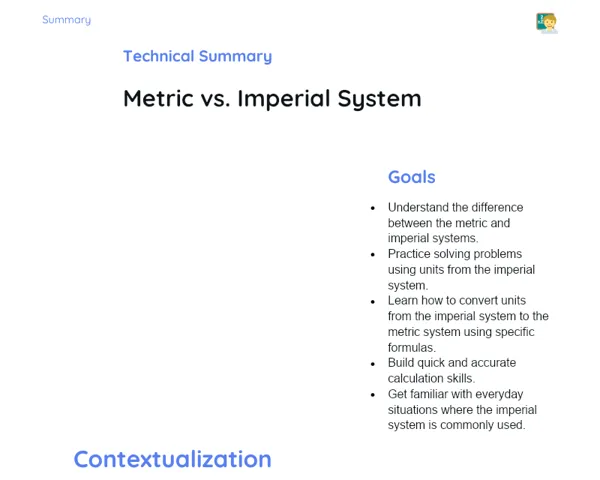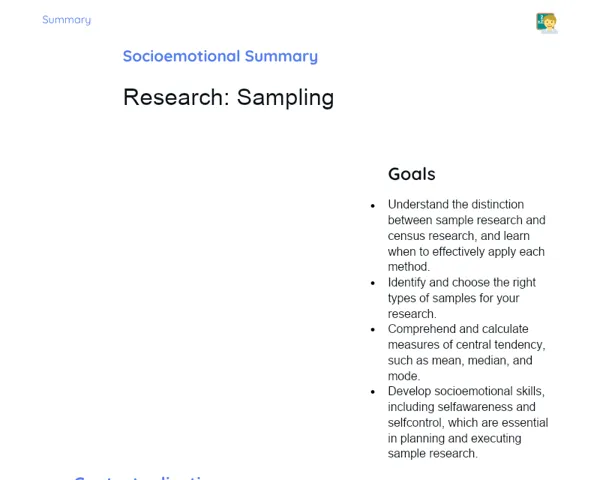Summary Tradisional | Combinatorial Analysis: Pascal's Triangle
Contextualization
Combinatorial Analysis is a fascinating segment of Mathematics that focuses on counting techniques and the arrangement of elements. A vital component within this field is Pascal's Triangle, which serves as a key method for calculating binomial coefficients—crucial for tackling combinatorial challenges. This triangle is constructed using rows of numbers, where each number is derived from the sum of the two numbers directly above it. This straightforward yet powerful structure offers various properties and practical applications.
Pascal's Triangle isn't just a mathematical curiosity; it's a practical resource used across numerous disciplines like probability, algebra, and even number theory. For instance, it aids in solving problems related to binomial expansion, where each row of the triangle corresponds to the coefficients for the expansion of a binomial power. Furthermore, the triangle's symmetry and the sum of its rows give valuable insights that streamline the resolution of complex problems.
To Remember!
Construction of Pascal's Triangle
Pascal's Triangle can be easily constructed. It begins with the number 1 at the top. Each following number is the sum of the two numbers positioned directly above it. All numbers at the edges of the triangle are 1. This construction can go on indefinitely, creating a symmetric triangular shape.
Understanding how to construct Pascal's Triangle is key to grasping its properties and applications. Each row represents binomial coefficients used in binomial expansion. For example, the third row of the triangle (1, 2, 1) corresponds to the coefficients of the expansion (a + b)², which equates to a² + 2ab + b².
This construction also visualizes important properties like symmetry and the sum of elements in each row. Additionally, it aids in understanding the calculation and application of binomial coefficients in combinatorial and probabilistic scenarios.
-
Pascal's Triangle initiates with the number 1 at the apex.
-
Each number onwards is the sum of the two numbers directly above it.
-
All numbers along the edges of the triangle are 1.
Binomial Coefficients
Binomial coefficients are the numbers found in Pascal's Triangle and play a key role in binomial expansion. The binomial coefficient C(n, k) signifies the number of ways to choose k elements from a collection of n elements, without considering the order. In the triangle, the item located at row n and column k equates to C(n, k).
These coefficients can be calculated using the formula C(n, k) = n! / [k!(n-k)!], where n! (n factorial) denotes the product of all positive integers up to n. For instance, C(5, 3) is computed as 5! / [3!(5-3)!] = 10. This foundational formula is pivotal for resolving combinatorial and probability issues.
Binomial coefficients exhibit intriguing properties, including symmetry, where C(n, k) = C(n, n-k). Hence, the elements of Pascal's Triangle mirror each other symmetrically. Also, the total of the coefficients in each row amounts to 2^n, where n indicates the row number.
-
Binomial coefficients can be identified in Pascal's Triangle.
-
C(n, k) denotes the ways to choose k elements from a total of n elements.
-
The coefficients can be concluded using the formula C(n, k) = n! / [k!(n-k)!].
Properties of Pascal's Triangle
Pascal's Triangle showcases various mathematical properties that assist in resolving combinatorial issues. A principal property is its symmetry; the triangle's elements are symmetrical around its center, meaning C(n, k) = C(n, n-k). This symmetry simplifies numerous combinatorial calculations.
Another noteworthy property includes the total of elements in each row, which is equal to 2^n, with n representing the row number. For example, the sum of elements in the third row (1, 2, 1) equals 1 + 2 + 1 = 4, which corresponds to 2². This property is advantageous in counting and probability contexts.
Pascal's Triangle is fundamentally linked to binomial expansion; each row correlates with the coefficients of a binomial power expansion, such as (a + b)ⁿ. This relation implies that the triangle can be utilized to derive the coefficients for any expanded binomial expression, simplifying complex algebraic calculations.
-
The symmetry of Pascal's Triangle: C(n, k) = C(n, n-k).
-
The sum of the elements in each row equates to 2^n.
-
The triangle is linked to binomial expansion.
Applications of Pascal's Triangle
Pascal's Triangle holds numerous practical applications across various fields of mathematics and applied sciences. In combinatorics, it calculates binomial coefficients essential for resolving counting and arrangement challenges, including determining how many ways to select k elements from a set of n elements.
In probability theory, Pascal's Triangle is leveraged to compute probabilities in binomial experiments. For example, it can assist in determining the chances of obtaining a specified number of successes through a series of independent experiments, like coin tosses.
In algebra, it simplifies binomial expansion, where each triangle row corresponds to the coefficients of a binomial power expansion. This utility aids in streamlining complex algebraic expressions. Additionally, its application extends to number theory, exploring numerical properties and patterns.
-
Pascal's Triangle is instrumental in calculating binomial coefficients.
-
It's utilized in probabilities for binomial experiments.
-
It aids in binomial expansion within algebra.
Key Terms
-
Pascal's Triangle: A mathematical structure for computing binomial coefficients.
-
Binomial Coefficients: Represent the number of ways to choose k elements from a set of n elements.
-
Symmetry: The characteristic of Pascal's Triangle where elements are equal on both sides.
-
Binomial Expansion: The process of expanding a binomial power, with coefficients derived from Pascal's Triangle.
Important Conclusions
In this lesson, we delved deeper into the construction and applications of Pascal's Triangle. We learned how to build the triangle, where every number emerges as the sum of the two directly above it, underscoring its symmetry and the sum of elements per row. We also covered how binomial coefficients are computed and their role in binomial expansion.
We highlighted the crucial properties of Pascal's Triangle—such as its symmetry and row sums—and its diverse applications in combinatorics, probability, and algebra. These traits greatly simplify solving complex problems, offering a richer appreciation of mathematical arrangements and counting.
The relevance of Pascal's Triangle transcends classroom learning, impacting fields such as number theory and genetics. We encourage our students to explore this topic further to enhance their understanding and discover new applications in various contexts.
Study Tips
-
Review how to create Pascal's Triangle and practice building the initial rows, paying attention to symmetry and row sums.
-
Study the binomial coefficients formula and tackle problems that involve selecting k elements from a total of n elements to solidify your knowledge.
-
Investigate Pascal's Triangle's practical uses in probability problems and binomial expansion, employing relatable everyday examples and mathematical problems.



